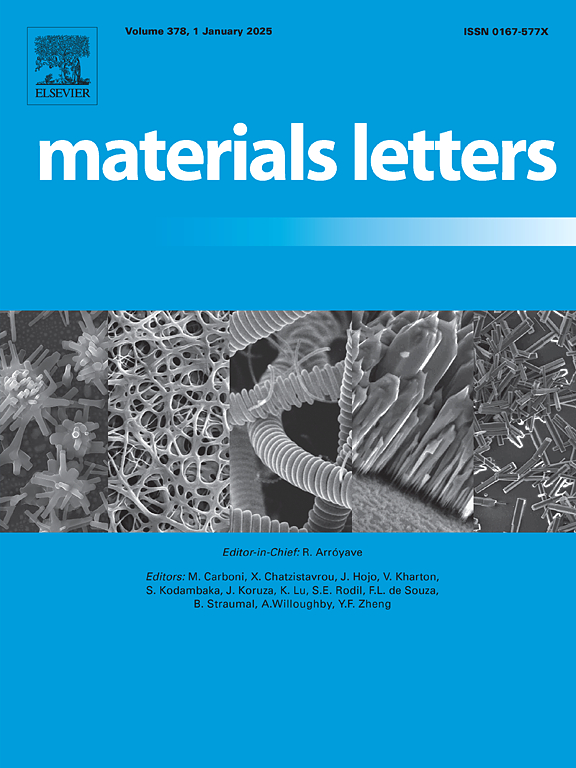提高钙钛矿太阳能电池长期稳定性的x-y纳米级相互作用策略
IF 2.7
4区 材料科学
Q3 MATERIALS SCIENCE, MULTIDISCIPLINARY
引用次数: 0
摘要
钙钛矿太阳能电池要实现商业化,长期的稳定性是必不可少的。在这里,我们首次提出了一种x-y纳米级相互作用策略来提高钙钛矿太阳能电池的稳定性,该策略的特点是由相互作用纳米棒阵列(NA)交错的钙钛矿层在纳米棒之间的纳米级间隙内沿衬底平面的x-y方向横向限制钙钛矿结晶。结果表明,将CH3NH3PbI3层渗透到生长在TiO2薄膜上的Sb2S3-NA中所得到的太阳能电池的抗湿稳定性比在TiO2薄膜上沉积CH3NH3PbI3层所制备的传统太阳能电池提高了86%。其中,稳定性的提高源于Pb2+和I -离子在x-y纳米CH3NH3PbI3晶体中的迁移和重排,这是由于这种纳米钙钛矿晶体与Sb2S3纳米棒之间的强相互作用。我们的发现为制备稳定的钙钛矿太阳能电池提供了一种新的方法。本文章由计算机程序翻译,如有差异,请以英文原文为准。
An x–y nanosized interaction strategy to boost long-term stability in perovskite solar cells
The long-term stability is indispensable to the commercialization of perovskite solar cells. Here, we propose for the first time an x–y nanosized interaction strategy to improve the stability of perovskite solar cells, which features a perovskite layer interdigitated by an interactive nanorod array (NA) to laterally limit the perovskite crystallization along x-y directions of substrate plane within nanosized inter-gaps between nanorods. Results show that the solar cell resulting from infiltrating CH3NH3PbI3 layer into the Sb2S3-NA grown on TiO2 film exhibits an improved stability against humidity by 86 % than the conventional counterpart device prepared by depositing bulk CH3NH3PbI3 layer on TiO2 film, where the improved stability originates from the limited migration and rearrangement of Pb2+ and I– ions in x-y nanosized CH3NH3PbI3 crystals by the strong interaction between such-nanosized perovskite crystals and Sb2S3 nanorods. Our findings provide a novel approach to prepare the stable perovskite solar cells.
求助全文
通过发布文献求助,成功后即可免费获取论文全文。
去求助
来源期刊

Materials Letters
工程技术-材料科学:综合
CiteScore
5.60
自引率
3.30%
发文量
1948
审稿时长
50 days
期刊介绍:
Materials Letters has an open access mirror journal Materials Letters: X, sharing the same aims and scope, editorial team, submission system and rigorous peer review.
Materials Letters is dedicated to publishing novel, cutting edge reports of broad interest to the materials community. The journal provides a forum for materials scientists and engineers, physicists, and chemists to rapidly communicate on the most important topics in the field of materials.
Contributions include, but are not limited to, a variety of topics such as:
• Materials - Metals and alloys, amorphous solids, ceramics, composites, polymers, semiconductors
• Applications - Structural, opto-electronic, magnetic, medical, MEMS, sensors, smart
• Characterization - Analytical, microscopy, scanning probes, nanoscopic, optical, electrical, magnetic, acoustic, spectroscopic, diffraction
• Novel Materials - Micro and nanostructures (nanowires, nanotubes, nanoparticles), nanocomposites, thin films, superlattices, quantum dots.
• Processing - Crystal growth, thin film processing, sol-gel processing, mechanical processing, assembly, nanocrystalline processing.
• Properties - Mechanical, magnetic, optical, electrical, ferroelectric, thermal, interfacial, transport, thermodynamic
• Synthesis - Quenching, solid state, solidification, solution synthesis, vapor deposition, high pressure, explosive
 求助内容:
求助内容: 应助结果提醒方式:
应助结果提醒方式:


